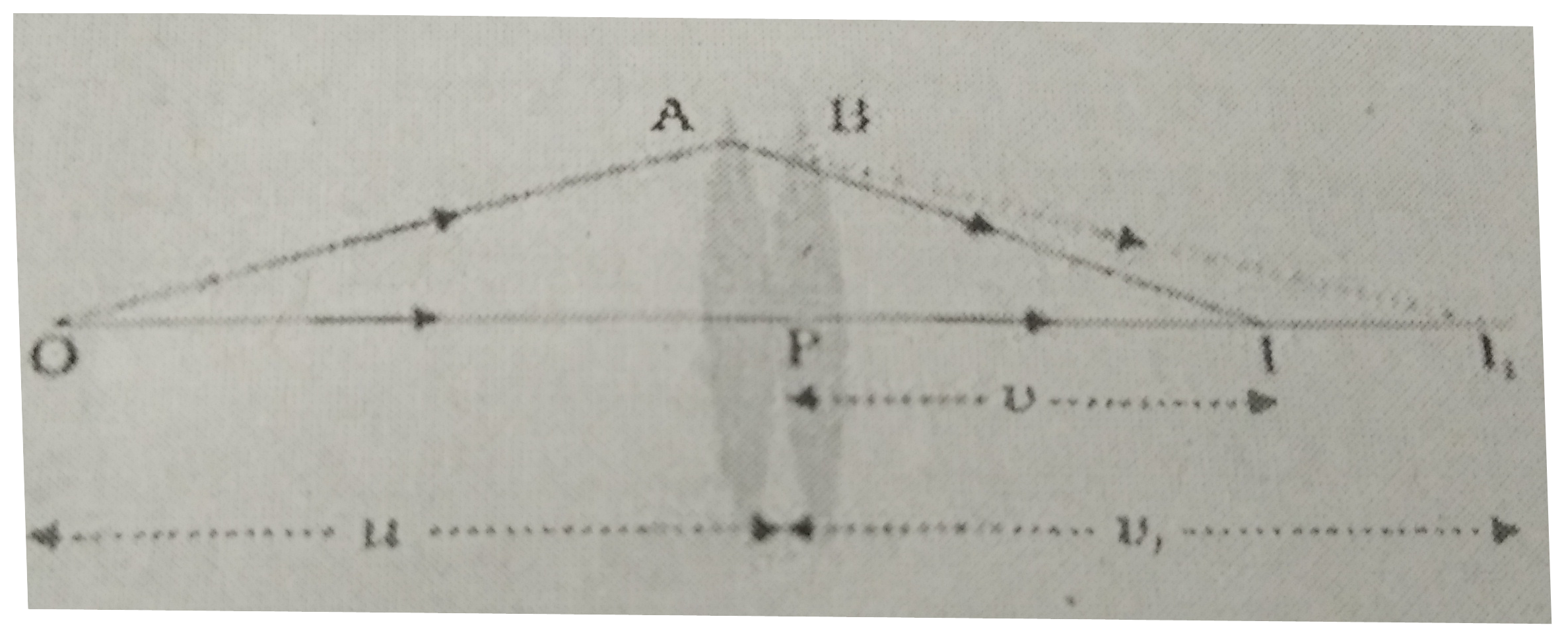(a) Draw a ray diagram to show the image formation by a combination of two thin convex
lenses in contact . Obtain the expression for the power of this combination in terms of the
focal lengths of the lenses.
(b) A ray of light passing from air through an equilateral glass prism undergoes minimum
deviation when the angle of incidence is 3(4)th of the angle of prism . Calculate the speed of ltbRgt light in the prism.
(a) Consider lenes A and B with focal length f1andf2 placed in contact . Object is placed at O
beyond focus of A . First lens produces image at I, (its real) and serve as virtual object for
lens B producing image I. As the lenses are lenses are thin , so optc centres of lenses are closer to
each other . Let this centre point be denoted by P.
Image formation by A 1v1−1u=1f1 and ...(i)
Image formation by B 1v−1v1=1f2 ...(ii)
Adding (i) and (ii) we get , 1v−1u=1f1+1f2 ...(iii)

If two lenses system is taken as one lens equivalent system then, eq . (iii) can be 1v−1u=1f
where, 1f=1f1+1f2. Then is valid for any number of lens f1,f2,f3... are the focal lengths
of lenses in contact
1f=1f1+1f2+1f3+.....u
P=P1+P2+P3+...
(b) Given, i=34A
Also, μ=sin[A+δm2]sinA2or,δm→ Angle of min . deviation .
or C1C2=sin[A+δm2]sinA2or,δm=2i−A=2×3A4−A=A2
δm=60∘2=30∘
C2=3×108√2ms−1=1.5√2ms−1×108
⇒C22.12×108 ms^(-1).
Topper's Solved these Questions
- XII BOARDSBOOK - XII BOARDS PREVIOUS YEARCHAPTER - XII BOARDSEXERCISE - SECTION-C
55 Videos
- XII BOARDSBOOK - XII BOARDS PREVIOUS YEARCHAPTER - XII BOARDSEXERCISE - PHYSICS (Theory) DELHI BOARD -2016 [SET -I][COMPTT.]
12 Videos
- XII BOARDSBOOK - XII BOARDS PREVIOUS YEARCHAPTER - XII BOARDSEXERCISE - SECTION-A
31 Videos
- SAMPLE PAPER 2019BOOK - XII BOARDS PREVIOUS YEARCHAPTER - SAMPLE PAPER 2019EXERCISE - SECTION D
6 Videos
Similar Questions
A ray of light passing through an equilateral triangular glass prism from air undergoes minimum deviation when angle of incidence is 34th of the angle of prism. Calculate speed of light in prism.
View SolutionA ray of light passing through an equilateral triangular glass prism from air undergoes minimum deviation when angle of incidence is 34th of the angle of prism. Calculate speed of light in prism.
View SolutionA ray of light passing through an equilateral triangular glass prism from air undergoes minimum deviation when angle of incidence is 34th th of the angle of prism. Calculate the speed of light in the prism.
View SolutionA ray of light passing through an equilateral triangular glass prism from air undergoes minimum deviation when angle of incidence is 3/4 th of the angle of prism. Calculate the speed of light in the prism.
View SolutionA ray of light passing through an equilateral triangular glass prism from air undergoes minimum deviation when angle of incidence is 3/4 th of the angle of prism. Calculate the speed of light in the prism.
View SolutionCalculate the speed of light in the prism if a ray of light is passing through an equilateral triangular glass prism from air and undergoes minimum deviation when angle of incidence is 5/4th of the angle of prism.
View SolutionA ray of light on passing through an equilateral glass prism, suffers a minimum deviation equal to the angle of the prism. The value of refractive index of the material of the prism is.......
View SolutionObtain an expression for focal length of a combination of thin lenses in contact.
View SolutionShow that a light ray will pass through an equilateral glass prism (μ=1.5). If the angle of incidence is greater than 30∘.
View SolutionDraw ray diagram showing the image formation by a convex lens when an object is placed at twice the focal length of the lens.
View Solution
